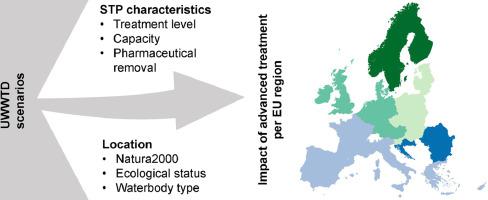Water Research ( IF 11.4 ) Pub Date : 2023-06-01 , DOI: 10.1016/j.watres.2023.120157 Joanke van Dijk 1 , Stefan C Dekker 2 , Stefan A E Kools 3 , Annemarie P van Wezel 4

|
Pharmaceuticals are known to widely occur in the environment and to affect the health of ecosystems. Sewage treatment plants (STPs) are main emission pathways for pharmaceuticals, which are often not sufficiently removed during wastewater treatment. In Europe, STP treatment requirements are specified under the Urban WasteWater Treatment Directive (UWWTD). The introduction of advanced treatment techniques, such as ozonation and activated carbon, under the UWWTD is expected to be an important option to reduce pharmaceutical emissions. In this study, we present a European-wide analysis of STPs reported under the UWWTD, their current treatment level and potential to remove a set of 58 prioritised pharmaceuticals. Three different scenarios were analysed to show 1) UWWTD present effectiveness, 2) the effectiveness at full UWWTD compliance, and 3) the effectiveness when advanced treatment is implemented at STPs with a treatment capacity of >100.000 person equivalents. Based on a literature study, the potential of individual STPs to reduce pharmaceutical emissions ranged from an average of 9% for STPs with primary treatment to 84% for STPs applying advanced treatment. Results of our calculations show that European-wide emission of pharmaceuticals can be reduced with 68% when large STPs are updated with advanced treatment, but spatial differences exist. We argue that adequate attention should also be paid with regards to preventing environmental impacts of STPs with a capacity <100.000 p.e.. Circa 44% of total STP effluent is emitted near Natura2000 sites (EU nature protection areas). Of all surface waters receiving STP effluent for which the ecological status has been assessed under the Water Framework Directive, 77% have a status of less than good. Relatively often only primary treatment is applied to wastewater emitted into coastal waters. This analysis can be used to further model pharmaceutical concentrations in European surface waters, to identify STPs for which more advanced treatment might be required and to protect EU aquatic biodiversity.
中文翻译:

欧洲范围内污水处理厂的空间分析以及深度处理减少药物排放对自然可能带来的好处
众所周知,药物广泛存在于环境中并影响生态系统的健康。污水处理厂 (STP) 是药物的主要排放途径,在废水处理过程中这些药物通常无法充分去除。在欧洲,城市污水处理指令 (UWWTD) 规定了 STP 处理要求。UWWTD 引入先进的处理技术,例如臭氧化和活性炭,预计将成为减少药物排放的重要选择。在这项研究中,我们对 UWWTD 下报告的 STP 进行了欧洲范围的分析,分析了它们目前的治疗水平以及去除一组 58 种优先药物的潜力。分析了三种不同的场景以显示 1) UWWTD 目前的有效性,2) 完全符合 UWWTD 的有效性,3) 在处理能力大于 100.000 人当量的 STP 实施高级处理时的有效性。根据一项文献研究,单个 STP 减少药物排放的潜力范围从采用初级处理的 STP 的平均 9% 到采用高级处理的 STP 的 84%。我们的计算结果表明,当大型 STP 更新为先进的治疗时,欧洲范围内的药物排放量可以减少 68%,但存在空间差异。我们认为,还应充分注意防止容量 <100.000 pe 的 STP 对环境的影响。大约 44% 的 STP 废水排放在 Natura2000 站点(欧盟自然保护区)附近。在根据水框架指令评估生态状况的所有接收 STP 废水的地表水中,有 77% 的状况不佳。通常只对排放到沿海水域的废水进行初级处理。该分析可用于进一步模拟欧洲地表水中的药物浓度,以确定可能需要更先进处理的 STP 并保护欧盟水生生物多样性。









































 京公网安备 11010802027423号
京公网安备 11010802027423号